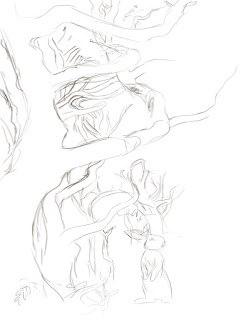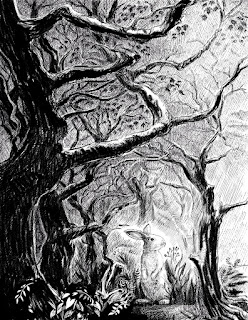I recently attended the SCBWI's regional conference for Indiana where I participated in an Illustrator's Intensive with Joann Hill, the Design Manager for Disney Hyperion. As part of the intensive we were given an assignment to create prior to the conference. We were allowed to choose from several texts that were chosen by Ms. Hill. From her list, I chose to illustrate three different nursery rhymes. We were required to do two picture book spreads, so I put two of the rhymes on one spread and gave the third rhyme its own spread.

Prior to beginning, I played around a little bit, experimenting with some techniques in Painter 12, which is the program I use for most of my illustration work. One of the rhymes I chose to do was A Misty Moisty Morning which tells of a child meeting a man dressed all in leather. I knew right away that if I wasn't careful, this could end up looking rather creepy. To try and negate the creepy factor, I did two things - First, I made the old man VERY old by giving him a long white beard, glasses and a cane. I tried to make him look harmless and sweet. Secondly, I gave the child, a dog. People are always asking me if they can pet my dog, so I thought a dog would be a good reason for the interaction between the old man and the child.
My experiment, which you can see above, was created by using painter's gouache brushes and some of the liquid ink pens. I ultimately decided against this technique and ended up using painter's 'real' watercolor brushes. But prior to starting on the finished spreads, we were asked to email Joann detailed pencil sketches so that she could give us feedback before we began our final paintings.
(By the way, you can click on any of these images to see them larger).
She liked my handling of the old man and the child very much but she felt that there were a couple of problems with the illustration for the second rhyme on the right side of the spread. The second rhyme I chose for this spread was "Simple Simon." She felt that my pieman looked a little too sly and the black crow standing on his backside, made him look a little too ominous. She also thought the boy looked too powerless. She felt that changing their facial expressions would help even out the dynamic between the two characters.
For the final painting, I changed the facial expressions on both the pieman and the boy and I changed the crow into a smaller, friendlier looking blue jay.
For the third rhyme, which was to go on the second spread, I chose "The Old Woman Who Lived in a Shoe." Since she is supposed to have so many children she didn't know what to do, I thought this would be a good opportunity to draw lots of kids engaged in various activities.
Below is a very early sketch, before I began to fill in many of the details.
Below is the finished sketch that I submitted for feedback.
She loved the positioning of the shoe and all of the activity going on with the kids. She especially liked the two children in the left foreground - the little boy teasing his sister with a frog. The suggestions she made on this illustration were fairly minor. She suggested that I have the boy hold the frog even closer to the girl's face. She also wondered why the old woman was scolding the one little boy so she suggested that maybe I show him with a paint brush and show that she has caught him painting grafitti on the shoe. In the upper right window of the shoe, she wondered why two children were in bed when all of the other children were outside playing.
Below is the final painting that I brought with me to the conference.
At the conference she looked at our final work and compared them to what we had originally sent to her. She seemed happy with all of the changes I made but she had a few comments on the colors for both illustrations. In the Misty Morning/Simple Simon piece, she felt that the figures needed to be a little darker to make them pop out more from the background. She felt that the pieman's shirt blended in to the background while his pants really stood out. She also felt the old man could be a couple of shades darker. In the Old Woman in the Shoe painting, she felt the shoe needed to be darker. After I got home, I worked on both illustrations and implemented her new suggestions. Below are the two finished pieces which I have added to my portfolio.
It was a fun project and it was a privilege to get to work with Ms Hill. I felt she had a real knack for seeing what worked and didn't work in my illustrations and her comments definitely helped turn them into better illustrations.










































